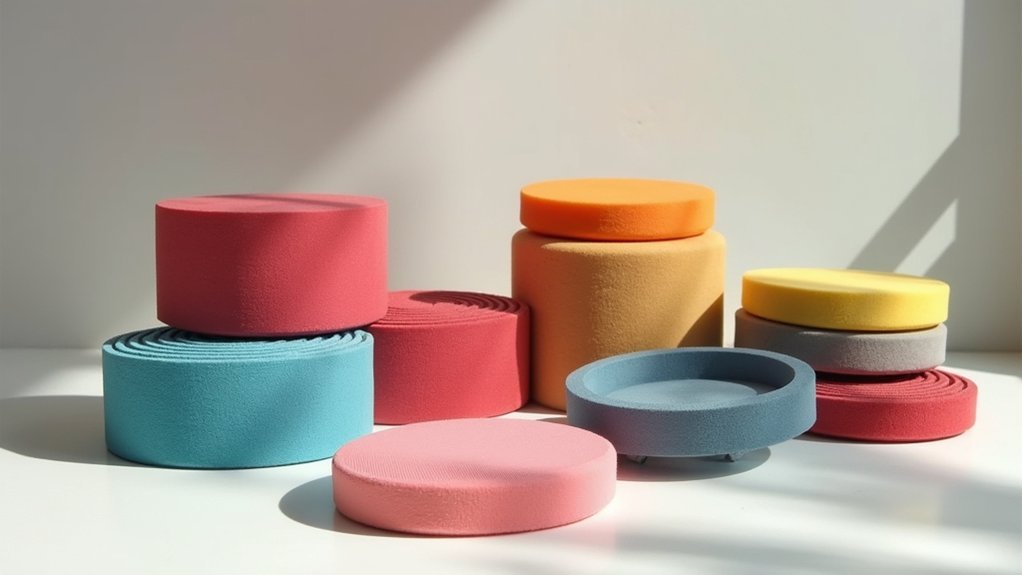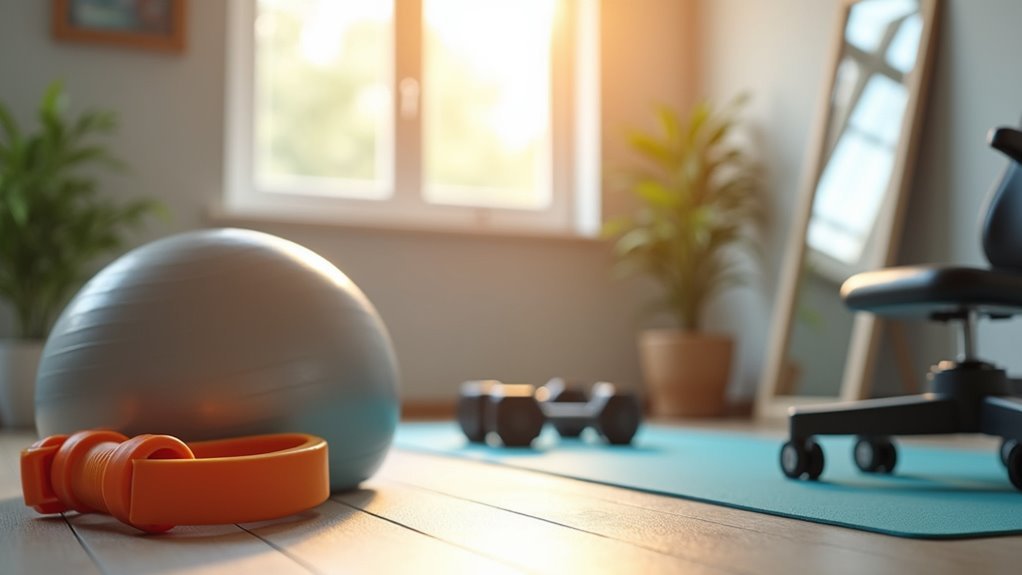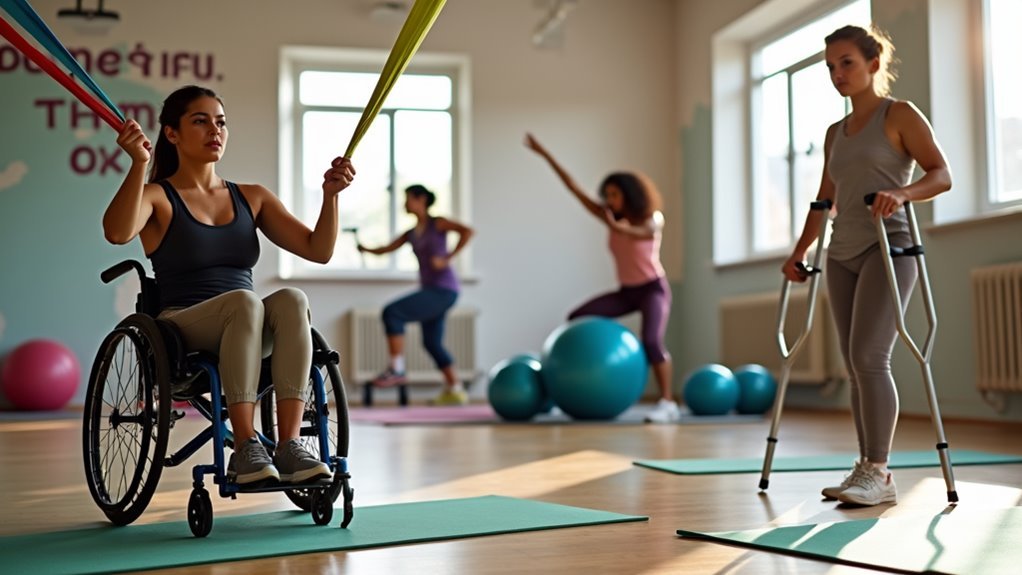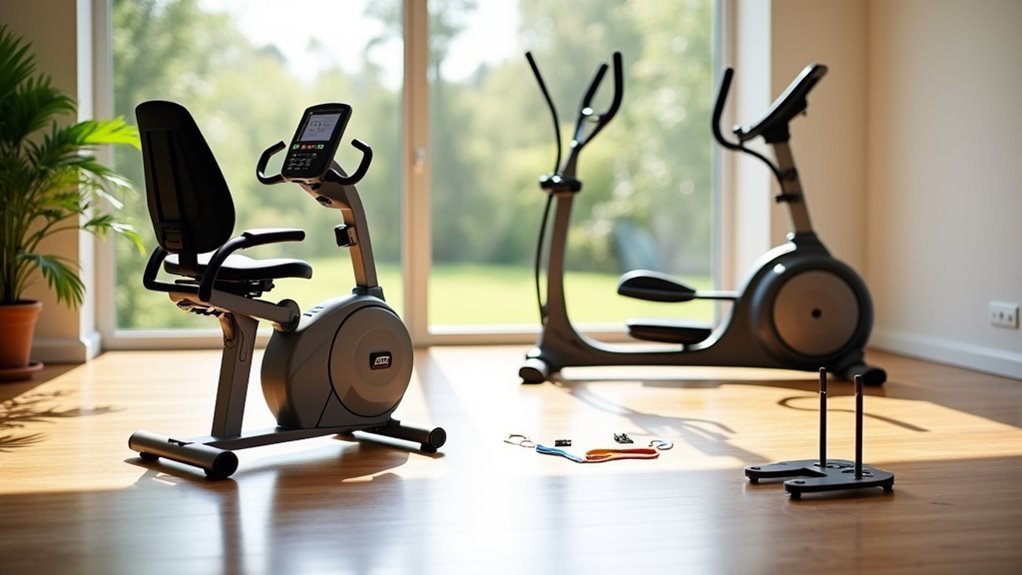You’ve likely seen those colorful foam pads at the gym but haven’t given them much thought. Balance pads aren’t just for physical therapy—they’re versatile tools that can dramatically improve your stability, coordination, and core strength. Whether you’re recovering from an injury, enhancing your yoga practice, or looking to challenge your fitness routine, the right balance pad makes all the difference. Let’s explore the top options that’ll transform your workout without breaking the bank.
Yes4All Foam Pad for Exercise and Physical Therapy
The Yes4All Foam Pad stands out as the ideal balance training solution for three key groups: rehabilitation patients, seniors, and fitness enthusiasts seeking stability improvement. Available in two sizes, this closed-cell foam pad supports up to 500kg with its anti-slip surface ensuring safety during workouts.
You’ll appreciate its versatility across yoga, pilates, and strength training routines. The thick cushioning protects your tailbone and reduces muscle pain while improving core stability. With 8,691 customers rating it 4.6/5 stars, it’s proven effective for physical therapy and balance enhancement. Plus, it comes with a 30-day return policy and 1-year warranty for peace of mind.
Best For: Rehabilitation patients, seniors, and fitness enthusiasts looking to improve balance, stability, and core strength through low-impact exercises and physical therapy.
Pros:
- Versatile design available in two sizes (Large and X-Large) with anti-slip surface and high weight capacity (500kg) for various exercise applications
- Thick cushioning provides excellent support for protecting the tailbone and reducing muscle pain during balance training
- Durable, sweat-resistant closed-cell foam construction that’s easy to clean and maintain for long-term use
Cons:
- May be too firm for some users who prefer softer cushioning for comfort
- Limited color options available for those who want to match with other fitness equipment
- Some users might find the larger size bulky for storage in smaller living spaces
Stability Trainer Foam Balance Pad for Exercise and Therapy
For rehabilitation patients and fitness enthusiasts alike, Aiweitey’s Stability Trainer Foam Balance Pad offers exceptional versatility with its TPE construction that supports up to 300 pounds. At 15.9 × 13 × 2 inches, this non-slip, water-resistant pad weighs just 0.28 kg, making it ideal for transport between therapy sessions or workouts.
You’ll appreciate its effectiveness for balance training, yoga, and physical therapy. With a stellar 4.6-star rating from 220 users, it’s proven to relieve knee and elbow pain while enhancing stability. Though some users desire larger dimensions for bigger feet, most praise its therapeutic benefits and convenient size.
Best For: Physical therapy patients, balance training enthusiasts, and fitness practitioners looking for a compact, supportive surface for rehabilitation exercises or balance-enhancing workouts.
Pros:
- Lightweight (0.28 kg) and portable design makes it easy to transport between therapy sessions or different workout locations
- Non-slip, water-resistant TPE material supports up to 300 pounds while providing comfortable cushioning for joints
- Versatile application for various exercises including yoga, Pilates, and physical therapy with proven effectiveness (4.6/5 star rating)
Cons:
- Size may be insufficient for users with larger feet who need more surface area
- At 2 inches thick, some users might prefer thicker options for more challenging balance exercises
- Limited to one color option (blue) which may not appeal to all users or match existing equipment
ProsourceFit Exercise Balance Pad for Fitness & Stability Training
Versatility defines the ProsourceFit Exercise Balance Pad, making it perfect for fitness enthusiasts seeking multiple training benefits from a single piece of equipment. Measuring 18.75″ x 15″ x 2.25″ and weighing just 16 ounces, this non-slip foam mat creates an unstable surface that enhances balance and builds core strength.
You’ll appreciate its non-toxic TPE material that’s both sweat-proof and slip-resistant. Whether you’re performing lunges, squats, or planks, or using it as a cushion for standing desks or meditation, this pad delivers reliable support. It’s especially valuable for rehabilitation exercises, accommodating all fitness levels while being easy to transport and clean.
Best For: Fitness enthusiasts of all levels looking for a versatile, compact tool to improve balance, strengthen core muscles, or provide comfortable cushioning during exercises and daily activities.
Pros:
- Lightweight (16 oz) and portable design allows for easy transport between home, gym, or outdoor workouts
- Multi-purpose functionality serves as both an exercise balance trainer and a comfortable cushion for knees, standing desks, or meditation
- Made from non-toxic, sweat-proof TPE material that’s environmentally friendly and easy to clean after use
Cons:
- Limited size (18.75″ x 15″) may not be sufficient for exercises requiring more surface area
- 2.25″ thickness may be too challenging for those with significant balance issues or beginners just starting stability training
- Single pad design requires purchasing multiple units for exercises that would benefit from dual balance pads
Foam Balance Beam for Stability Rehabilitation and Physical Therapy
Recovering from injuries often requires specialized equipment that’s both effective and gentle on healing bodies. The Healthy You Foam Balance Beam offers exactly that with its extra soft foam construction measuring 64 x 6 x 2.5 inches.
At just 0.91 kilograms, you’ll find it easy to reposition between therapy sessions. The non-porous blue foam cleans effortlessly, making it ideal for clinic or home use.
With a 4.6-star rating from 96 users, this balance beam proves particularly valuable for stroke recovery and post-hip replacement rehabilitation. You can even incorporate assistive devices like canes for added safety during your stability training.
Best For: Adult patients recovering from stroke, hip replacement surgery, or other injuries requiring balance rehabilitation in both clinical and home settings.
Pros:
- Extra soft foam construction provides a safe challenge while being gentle on healing bodies
- Lightweight (0.91 kg) and portable design allows for easy repositioning during therapy sessions
- Non-porous material is durable and easy to clean, making it suitable for multiple users in clinical settings
Cons:
- At 2.5 inches high, may not provide enough challenge for advanced rehabilitation patients
- Limited width (6 inches) may be too narrow for some users with significant balance issues
- Blue color only, which may not be appealing to all users or match existing therapy equipment
AIREX Balance Pad for Stability Training and Physical Therapy
Physical therapists overwhelmingly recommend the AIREX Balance Pad as their #1 choice for professional therapy and home rehabilitation. This lightweight foam pad creates just enough instability to strengthen your joints, ankles, and knees while improving balance and flexibility.
Made from closed-cell foam, it repels moisture and odors for easy maintenance. You’ll appreciate its tear-resistant surface that provides extra grip, especially when used barefoot. The pad maintains its shape over time, never sagging or curling.
You can use it for multiple purposes—as a workout pad, yoga cushion, kneeling pad, or even for hydrotherapy as it’s waterproof and floats.
Best For: Physical therapy patients, individuals with balance or stability issues, and fitness enthusiasts looking to enhance their core strength training routines.
Pros:
- Highly recommended by physical therapists, making it a trusted choice for rehabilitation exercises
- Durable closed-cell foam construction repels moisture and maintains shape over time
- Versatile for multiple uses including balance training, yoga, kneeling pad, and even hydrotherapy
Cons:
- Higher price point compared to generic balance pads
- Single pad may not provide enough challenge for advanced users
- Bulkier than some alternative balance training tools, potentially making storage more difficult
Hanaive Foam Pad Balance Mat (3 Pcs) for Physical Therapy & Training
The three-piece Hanaive Foam Pad Balance Mat stands out as an exceptional choice for anyone looking to improve stability while recovering from injury. Each blue TPE pad measures 11 x 7 x 2.4 inches and features a textured, non-slip surface that works well whether you’re barefoot or wearing shoes.
You’ll appreciate the versatility of these lightweight 3.5-ounce mats. They’re perfect for yoga, Pilates, and physical therapy exercises, but you can also use them as anti-fatigue mats during gardening or cleaning. Their waterproof, sweat-proof design makes cleaning easy while providing the unstable surface needed to enhance your core strength and coordination.
Best For: Individuals seeking to improve balance, stability, and core strength during physical therapy, rehabilitation, or fitness training, particularly older adults or those recovering from injuries.
Pros:
- Comes as a set of three lightweight TPE pads that are portable and versatile for various exercises and activities
- Features textured, non-slip surfaces that provide secure footing whether used barefoot or with shoes
- Waterproof and sweat-proof design makes them easy to clean and maintain after use
Cons:
- At 11 x 7 inches, the pads may be smaller than some users expect for certain stability exercises
- Limited color option (only available in blue) might not appeal to all users
- Some users might find the 2.4-inch thickness either too firm or too soft depending on their specific needs
THERABAND Stability Trainer Pad for Balance & Core Strengthening
Athletes seeking professional-grade stability training will find the THERABAND Stability Trainer Pad exceptionally versatile. This durable oval-shaped pad features a dual-sided design with tactile points on one side and anti-skid bars on the other.
Available in four progressive densities, it’s ideal for rehabilitation, injury prevention, and performance enhancement. You’ll notice improved balance and core strength while using it for proprioception training or closed kinetic chain exercises.
The blue medium pad works well for intermediate users, while beginners should start with the green option. Its portable design means you can easily take it to workouts, and its sturdy construction guarantees longevity.
Best For: Athletes, physical therapy patients, and fitness enthusiasts seeking to improve balance, strengthen core muscles, rehabilitate from injuries, or enhance sports performance through progressive stability training.
Pros:
- Available in four color-coded density levels allowing for progressive training from beginner (green) to advanced levels
- Dual-sided design featuring tactile points for sensory input on one side and anti-skid bars on the other for versatile workout options
- Durable PVC and closed-cell foam construction ensures longevity while remaining portable enough for travel to workouts and games
Cons:
- Current size (14.5 x 8 x 1.75 inches) may be too large for some users with smaller feet or limited space
- May not provide enough challenge for very advanced athletes who need extreme instability for training
- Higher price point compared to basic balance pads without the progressive density options
Balance Pad XL for Physical Therapy and Core Training
For individuals seeking a balance pad with exceptional surface area and durability, ANVICTOX’s Balance Pad XL stands out as a premium choice. Measuring 19.8 × 15.7 × 2.4 inches, this TPE pad provides ample space for stability exercises regardless of your body type.
You’ll appreciate the pad’s resilient construction that withstands various environments while offering excellent anti-slip performance. Its design enhances balance, coordination, and muscle control while reducing injury risk.
When using this pad, avoid placing feet on the edges to maximize stability and extend the product’s lifespan. ANVICTOX backs their product with a one-year warranty and 24/7 customer support.
Best For: Adults seeking a large, stable balance pad for physical therapy, rehabilitation exercises, or core training who need extra surface area and reliable anti-slip performance.
Pros:
- Extra-large dimensions (19.8 × 15.7 inches) provide ample space for various exercises and accommodate different body types
- Made from durable TPE material with excellent elasticity, wear resistance, and easy maintenance
- High customer satisfaction evidenced by 4.7/5 star rating from 159 users
Cons:
- At 570 grams, it may be heavier than some alternative balance pads
- Placing feet on edges can compromise stability and reduce the product’s lifespan
- Only available in one color option (Blue-XL)
Balance Pad for Physical Therapy and Stability Workout
When seeking versatile support for rehabilitation or fitness training, balance pads offer an ideal solution for individuals of all ages and abilities. Available in two sizes—standard (15.8 × 13.2 × 2 inches) and XL (19.8 × 15.7 × 2.4 inches)—you’ll find options suited for different body types and training needs.
Made from durable TPE material, these pads enhance balance, coordination, and stability while reducing injury risk. They’re particularly effective for relieving muscle tension and accelerating recovery.
For maximum benefit and pad longevity, avoid placing your feet on the edges during use. With a 4.6-star rating and one-year warranty, you’ll enjoy reliable support for your stability journey.
Best For: Individuals seeking to improve their balance, stability, and coordination during physical therapy, rehabilitation, or fitness training, regardless of age or physical ability.
Pros:
- Available in two sizes to accommodate different body types and training needs
- Made from durable TPE material that’s easy to clean and suitable for various environments
- Effectively reduces injury risk while helping relieve muscle tension and promoting recovery
Cons:
- Placing feet on the edges can compromise stability and may lead to injuries
- Regular edge usage can damage the pad and decrease its lifespan
- Standard size may be too small for taller individuals, requiring purchase of the XL version
Non-Slip Balance Foam Pad for Exercise and Physical Therapy
Stability seekers who need versatile rehabilitation equipment will find the Strainho Non-Slip Balance Foam Pad an excellent addition to their exercise arsenal. Its non-toxic TPE foam construction offers durability while remaining lightweight at just 0.8 pounds.
You’ll appreciate the pad’s versatility—use it for physical therapy exercises, as an anti-fatigue mat, or even as a seat cushion. The innovative non-slip texture guarantees safety during balance training, whether you’re recovering from injury or enhancing athletic performance.
For best results, use it barefoot or with socks. With impressive 4.6-star ratings and a 24-month warranty, this waterproof, easy-to-clean pad delivers reliable support for your stability journey.
Best For: People recovering from injuries, physical therapy patients, fitness enthusiasts seeking balance training, or professionals needing an anti-fatigue mat for standing desks.
Pros:
- Versatile design allows for multiple uses including physical therapy, balance training, anti-fatigue mat, and seat cushion
- Lightweight (0.8 lbs) and portable with non-slip texture ensuring safety during exercises
- Durable, waterproof TPE foam material that’s easy to clean and resistant to tears, germs, and moisture
Cons:
- Cannot be used with shoes, limiting some exercise applications
- At 2.05 inches thick, may not provide enough challenge for advanced balance training
- Some users might find the 15.4 x 12.6 inch dimensions restrictive for certain exercises or standing positions
Factors to Consider When Choosing Foam Balance Pads for Stability Training
When you’re shopping for a foam balance pad, you’ll need to evaluate several essential factors to guarantee you get the right one for your stability training needs. Consider the size and dimensions that fit your workout space, the quality of materials for durability, appropriate cushioning thickness for your skill level, surface grip patterns that provide the right challenge, and weight capacity that safely supports your body. These considerations will help you select a balance pad that enhances your training effectiveness while preventing potential injuries.
Size and Dimensions
Selecting the right dimensions for your foam balance pad can considerably impact your stability training effectiveness. Most pads range from compact 11 x 7-inch models to spacious 19.8 x 15.7-inch options, allowing you to choose based on your specific needs.
Consider the pad’s thickness—typically 2 to 2.5 inches—as thicker pads provide more cushioning for joint protection while creating greater stability challenges. Your body type matters too; taller or larger individuals should opt for XL pads that offer better support and a wider surface area.
Match your pad size to your intended activity. Rehabilitation exercises might require smaller, more manageable dimensions, while yoga or extensive strength training benefits from larger surfaces. Don’t overlook weight capacity—most quality pads support 300-500 kilograms, ensuring safety throughout your stability training journey.
Material Quality
The foundation of any effective balance pad lies in its material composition. When shopping for stability training pads, prioritize closed-cell foam options that resist moisture and are easy to clean after intense workouts. High-quality TPE materials offer superior elasticity and resilience, ensuring your pad maintains its shape even after regular use.
You’ll want to check that your balance pad features non-toxic, sweat-resistant materials—especially important during longer training sessions when comfort becomes essential. Pay close attention to surface texture, as proper grip greatly enhances safety during challenging exercises. The best balance pads provide non-slip features that keep you stable while pushing your limits.
Don’t overlook portability factors; lightweight materials make a considerable difference when you’re carrying your pad to different training locations or storing it between workouts.
Cushioning Thickness
Cushioning thickness represents a key factor that directly impacts your stability training experience. Most foam balance pads range from 2 to 2.5 inches thick, offering different benefits depending on your specific needs.
If you’re focused on rehabilitation or have joint concerns, you’ll likely prefer a thicker pad (closer to 2.5 inches) for enhanced cushioning and pressure point relief during extended use. However, be aware that thicker pads create more instability, which can be challenging for beginners.
For peak balance and core strength development, the 2 to 2.5-inch range provides an ideal compromise between stability and cushioning. Consider your training goals carefully—thicker pads excel at joint protection but may inhibit some stability exercises, while slightly thinner options offer more control for advanced training routines.
Surface Grip Pattern
Five distinct surface grip patterns dominate the foam balance pad market, each offering unique benefits for your stability training journey. When selecting your pad, you’ll want to pay close attention to the texture design that best suits your needs.
Non-slip patterns with ridges or bumps provide essential traction that prevents dangerous sliding during challenging exercises. These textured surfaces don’t just enhance safety—they actively stimulate your feet, improving proprioception and body awareness during workouts.
If you’re prone to sweating, look for moisture-resistant grip patterns that maintain stability even during intense sessions. Remember that grip patterns vary in difficulty level; beginners might prefer more pronounced textures for confidence, while advanced users might choose subtler patterns that create additional stability challenges.
Weight Capacity
Selecting a foam balance pad with appropriate weight capacity stands as one of the most essential safety considerations for stability training. Most balance pads support between 300 lbs and 500 kg, so you’ll need to choose one that safely accommodates your body weight plus any additional equipment you’ll use during exercises.
Don’t risk your safety by exceeding the manufacturer’s specified weight limits. Overloading your balance pad can compromise its stability and structural integrity, potentially leading to injuries during your workout. Balance pads with higher weight capacities typically feature more robust construction, offering better support for users who need extra stability during training.
Always check the product specifications before purchasing to guarantee the pad will properly support you through all your stability exercises and training routines.
Maintenance Requirements
After ensuring your balance pad can support your weight, you’ll want to contemplate how much care it requires over time. Look for pads made from TPE or closed-cell foam, as these materials resist moisture and odors, making them easier to maintain.
The best foam pads feature waterproof surfaces you can simply rinse with fresh water and air-dry after sweaty workouts. Check if your potential purchase is sweat-proof and includes a non-slip surface—these qualities not only enhance safety but also simplify cleaning.
Inspect your pad regularly for signs of wear, especially along the edges which tend to deteriorate first with frequent use. Always follow manufacturer-specific care instructions, avoiding high heat and harsh chemicals that could damage the material and compromise your pad’s effectiveness and longevity.
Frequently Asked Questions
How Long Do Foam Balance Pads Typically Last Before Needing Replacement?
You’ll find foam balance pads typically last 1-3 years with regular use. Your pad’s lifespan depends on usage frequency, weight applied, and material quality. Replace it when you notice significant flattening or cracking.
Can Foam Pads Be Used Outdoors on Grass or Concrete Surfaces?
Yes, you can use foam pads outdoors on grass or concrete. They’re versatile for both surfaces, though concrete provides more stability. Just clean them afterward to prevent dirt buildup and premature wear.
Are Balance Pads Safe for Children to Use During Play?
Balance pads can be safe for children during play if you’re supervising them. They’re great for developing coordination, but you’ll want age-appropriate sizes and to establish clear safety rules to prevent accidents.
How Do You Clean and Maintain Foam Balance Pads?
You’ll need to clean foam balance pads with mild soap and water, then air dry completely. Don’t use harsh chemicals. Store them flat in a dry place and inspect regularly for wear and tear.
Do Foam Pads Lose Their Effectiveness if Used Daily?
Foam pads will gradually lose effectiveness with daily use as the material compresses. You’ll notice reduced cushioning after 3-6 months of heavy use. Rotate between multiple pads and give them rest days when possible.





Leave a Reply